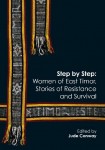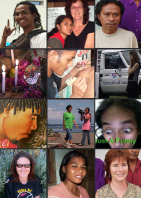
Review by Jen Hughes
Step by Step: Women of East Timor, Stories of Resistance and Survival edited by Jude Conway and launched in Australia nationally in 2010, presents 13 oral histories from Timorese women, with each story accompanied by several pages of photographic snapshots from their lives.
The collection of stories reveal the role women played in East Timor’s independence struggle on the guerilla front, the diplomatic front and in the student movement inside and outside the country and afterwards.
The opening story told by Ceu Lopes Federer provides a lens through which to read the subsequent twelve stories. The work Ceu and her compatriots did to meet the financial needs of the resistance inside and outside Timor, to keep it alive and strong, and to provide them with accurate information about what was going on outside in relation to East Timor gives the reader an insight into how important women were in the solidarity movement that was the backbone to the diplomatic front. Mica Barreto Soares’ story tells how Timorese studied in Indonesia and the work they did for East Timor inside Indonesia. The two show the importance of the women’s solidarity work to the survival of the guerilla movement inside Timor and segue into the stories about the work Timorese women did all over the world. They also provide background for the sometimes small but extremely risky activities of other storytellers when they speak of secreting letters and notes, medicines or food, inside clothing and bluffing their way through Indonesian positions inside East Timor and Indonesia.
The simple device of providing an introductory paragraph about the circumstances of their family and ethnicity at birth in all the stories yields rich rewards by giving access to the intricate and personal character of conflicts of this kind, making a broader reading of how women and their families experience conflict possible. The stories make it clear, that war was everywhere and everywhere they turned every aspect of personal life was affected by it. Their family histories and the location in time and place of the storytellers dramatically impacts on the destiny of the women and their children.
The most heart wrenching story in the book is of a child who wished her mother, Dulce Vitor, dead because it was her military were chasing, and because of her they were hungry and had to run every day.
This collection of stories tells what the everyday embodiment of a conflict in your own community is like for families. It was in the fertile ground of dire need and ambition, in amongst the secrets, on the boundaries of family relationships, political and institutional alliances, the seeds of fear and distrust could be sewn by enemies, or serendipitously falling there, cause discovery and tempt betrayal. However it was in similar fissures and trusted spaces deeply embedded in the community that the resistant impulses became active too. The stories show, it was from the domestic spaces that courage, adaptability, resistance and resilience grew and spread over generations to the clandestine movement inside the country and the solidarity movement outside the country.
The various reasons for these women getting involved in the struggle for East Timor’s independence gives an insight into why these stories are critically different from oral histories about women’s involvement in war I’ve read before. Most of them became caught up because of their experience of the forced oppression and violence against themselves, their family and their fellow human beings. Carolina Do Rosario “As Timor women we felt worthless, little more than dolls. We felt that slaves had a history we shared, … that’s why…. we never walked away from the struggle, we kept fighting”. And Laura Soares Abrantes: “how can one practice culture without human rights”?
A book of oral histories runs the risk of losing the reader because the writing lacks the page-turning pulse that dramatic tension provides in a woven narrative. However the power of these stories resides in the realistic immediacy and verifiability of their first person narratives, published as they are while the protagonists still live. This personal as political approach to a historical record of an international political conflict, adds weight to the gender struggle that is on-going in East Timor, a deeply conservative male dominated society. The women want us to know the fight for equality was not introduced by foreigners but has grown from the struggle for independence. It is significant the stories have been published for a broader English-speaking readership. If the stories were recorded and used for research before being abstracted into a history authored by Conway rather than edited as they are they wouldn’t serve the same function politically or be as satisfying for the storytellers.
One of the strengths of the book is the history of the editor Jude Conway. Jude worked side by side with Timorese in Darwin and Dili for twenty years and many of the photographs in the book taken by her, amplify the stories, showing somewhat disconcertingly, how social life continued; how love and marriage, birth and friendship, educational achievement and the women themselves were growing older and their lives were changing during the time of the stories. The photograph albums for each storyteller are available on Conway’s FaceBook page here: http://www.facebook.com/media/albums/?id=746873182
Step by Step is a highly readable, timely collection of oral histories that shines a light on the pivotal role women played in East Timor’s struggle for independence and afterwards, inside and outside East Timor. I highly recommend it.
Jen Hughes is a writer and filmmaker. Producer/Director of The Circle of Stones (2001), Time to go John and Black Bullion (2003) as well as producer and co–author of http://www.suaimediaspace.org/ She has had eleven years involvement with East Timor, assisting the youth of Suai and the Friends of Suai: http://www.suaimediaspace.org/friends-of-suai-port-phillip/ set up a media training group YoMaTre:. http://www.suaimediaspace.org/youth/









